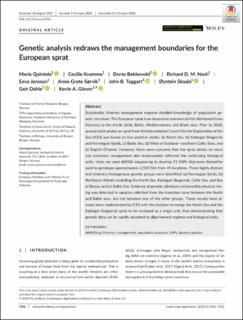| dc.description.abstract | Sustainable fisheries management requires detailed knowledge of population genetic structure. The European sprat is an important commercial fish distributed from Morocco to the Arctic circle, Baltic, Mediterranean, and Black seas. Prior to 2018, annual catch advice on sprat from the International Council for the Exploration of the Sea (ICES) was based on five putative stocks: (a) North Sea, (b) Kattegat–Skagerrak and Norwegian fjords, (c) Baltic Sea, (d) West of Scotland—southern Celtic Seas, and (e) English Channel. However, there were concerns that the sprat advice on stock size estimates management plan inadequately reflected the underlying biological units. Here, we used ddRAD sequencing to develop 91 SNPs that were thereafter used to genotype approximately 2,500 fish from 40 locations. Three highly distinct and relatively homogenous genetic groups were identified: (a) Norwegian fjords; (b) Northeast Atlantic including the North Sea, Kattegat–Skagerrak, Celtic Sea, and Bay of Biscay; and (c) Baltic Sea. Evidence of genetic admixture and possibly physical mixing was detected in samples collected from the transition zone between the North and Baltic seas, but not between any of the other groups. These results have already been implemented by ICES with the decision to merge the North Sea and the Kattegat–Skagerrak sprat to be assessed as a single unit, thus demonstrating that genetic data can be rapidly absorbed to align harvest regimes and biological units. | en_US |
